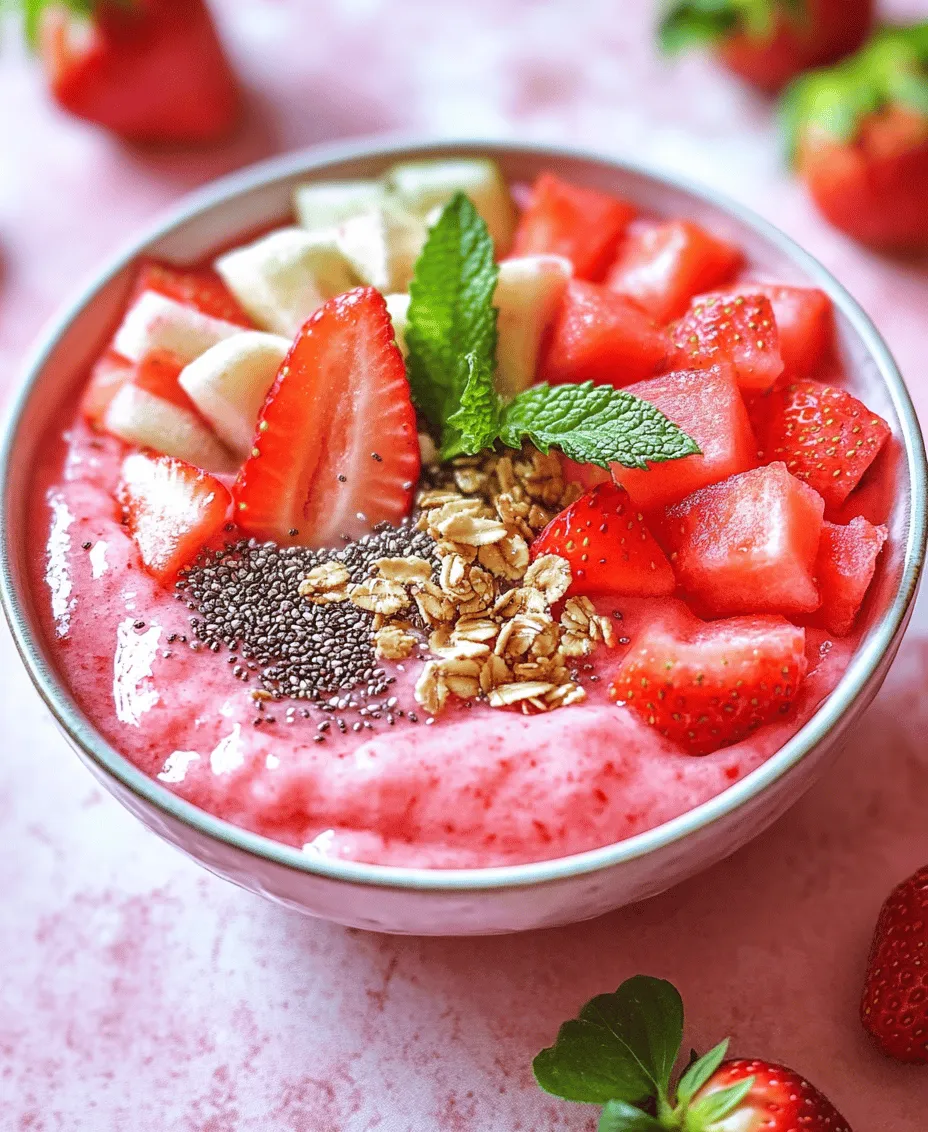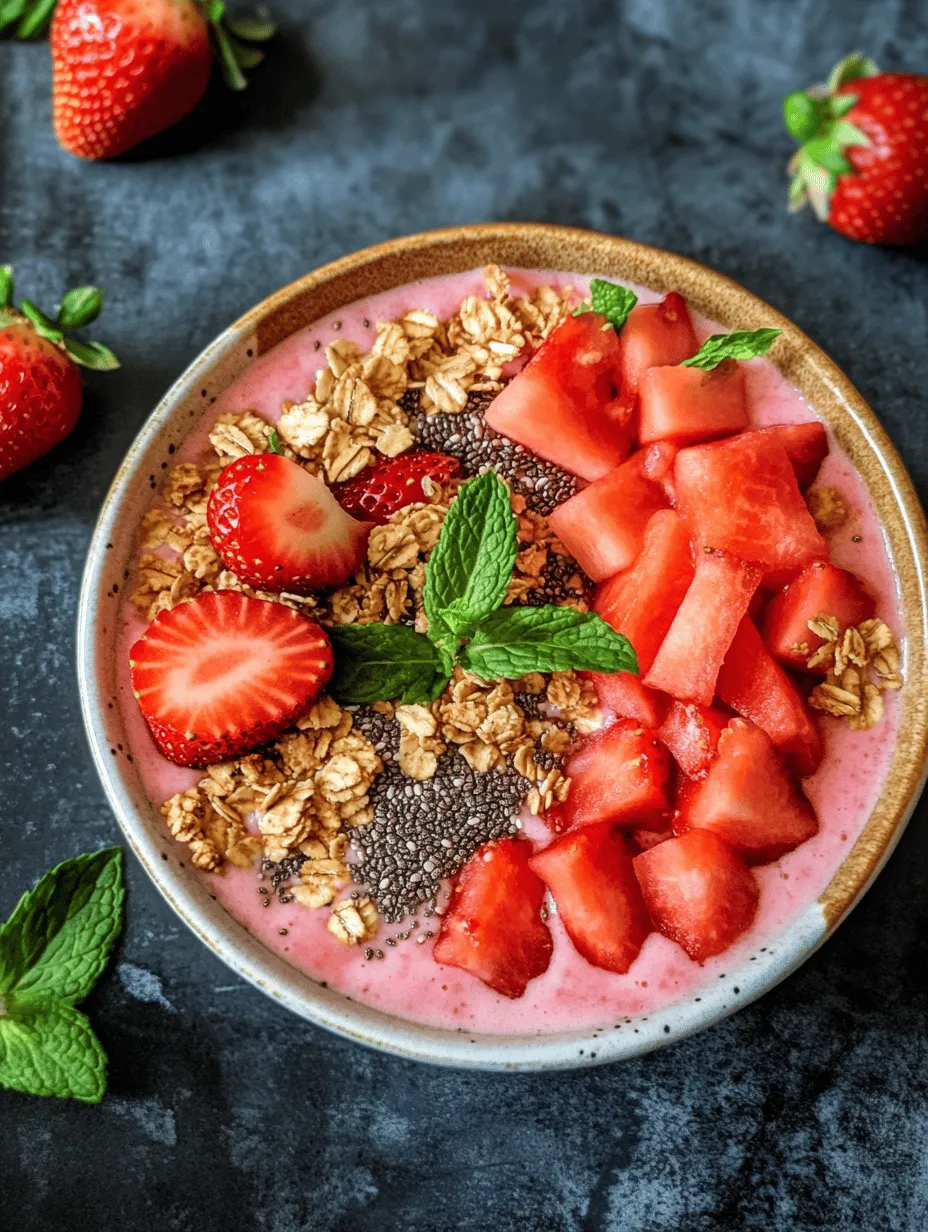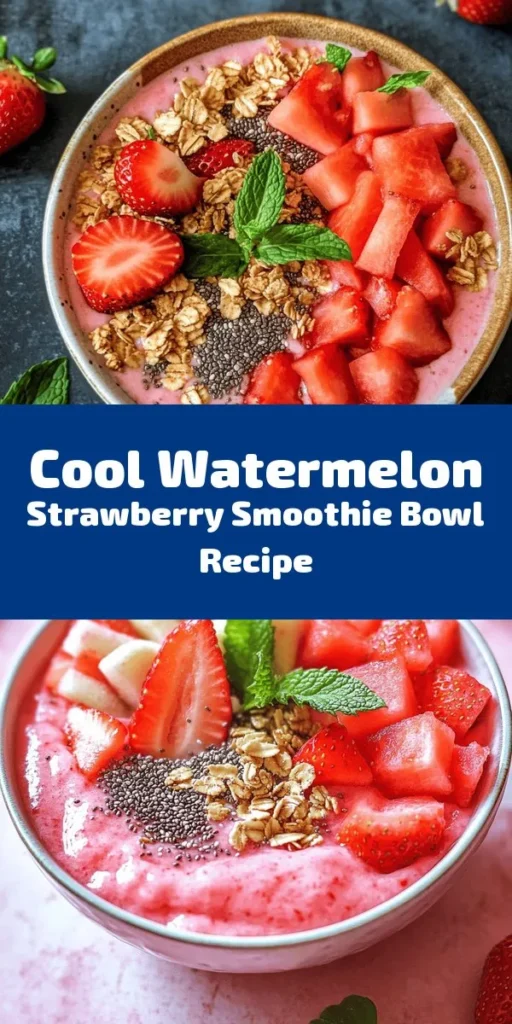Introduction
Smoothie bowls have surged in popularity in recent years, becoming a staple in health-conscious kitchens and trendy cafes alike. These vibrant, colorful bowls not only captivate the eye but also pack a nutritional punch that makes them an excellent choice for breakfast, snacks, or even dessert. The appeal of smoothie bowls lies in their versatility; they can be customized with various fruits, toppings, and flavors to suit personal preferences and dietary needs. In particular, the refreshing watermelon and strawberry smoothie bowl stands out as a perfect summer treat, capturing the essence of the season with its bright colors and delicious flavors.
This watermelon and strawberry smoothie bowl is not only delightful to eat but also incredibly healthy. Watermelon, strawberries, and bananas are the star ingredients, each contributing unique benefits that promote hydration, nutrition, and overall well-being. As we delve into this recipe, we will explore the health advantages of these fruits and guide you through the steps to create your own refreshing smoothie bowl.
Understanding the Ingredients
Nutritional Profile of Watermelon
Watermelon is often hailed as the quintessential summer fruit, and for good reason. This juicy, red fruit is primarily composed of water—about 92%—making it an excellent choice for hydration on hot summer days. One cup of diced watermelon contains approximately 46 calories, making it a low-calorie option that can satisfy your sweet tooth without derailing your diet. Watermelon is also rich in vitamins A and C, both of which play vital roles in skin health and immune function.
Furthermore, watermelon contains an amino acid called citrulline, which has been shown to improve blood flow and reduce muscle soreness. This makes it a fantastic post-workout snack, especially in smoothie form. The natural sugars in watermelon provide a quick energy boost, making it an ideal ingredient for smoothies that aim to refresh and revitalize.
Hydration Benefits and Low-Calorie Content
The high water content of watermelon not only contributes to its refreshing taste but also provides significant hydration benefits. Staying hydrated is crucial for maintaining energy levels, cognitive function, and overall health, especially during the sweltering summer months. Incorporating watermelon into your diet can help you meet your hydration needs while offering a naturally sweet flavor that enhances any dish or drink.
Nutritional Benefits of Strawberries
Strawberries are another powerhouse fruit that enhances the health benefits of this smoothie bowl. These vibrant berries are packed with nutrients, including vitamin C, manganese, folate, and potassium. A single cup of sliced strawberries contains about 50 calories and is rich in antioxidants, which help combat oxidative stress and inflammation in the body.
The fiber content in strawberries also supports digestive health, making them a great addition to any meal. Their natural sweetness pairs wonderfully with the refreshing taste of watermelon, creating a delightful flavor combination that is both satisfying and nutritious.
The Role of Bananas in Smoothies
Bananas play a crucial role in this smoothie bowl, contributing natural sweetness and a creamy texture that elevates the overall experience. A medium banana contains approximately 105 calories and is an excellent source of potassium, which is essential for heart health and muscle function. The natural sugars in bananas provide a quick energy boost, and their creamy consistency helps achieve a smooth, velvety texture in the smoothie.
Importance of Coconut Water and Greek Yogurt
To enhance the flavor and nutritional profile of the smoothie bowl, we will include coconut water and Greek yogurt. Coconut water is a natural source of electrolytes, making it an excellent choice for hydration. It contains potassium, sodium, and magnesium, which help replenish lost electrolytes during hot weather or after exercise.
Greek yogurt adds a creamy texture while also providing a good source of protein. A typical serving of Greek yogurt contains about 15-20 grams of protein, which helps keep you feeling full and satisfied. Additionally, Greek yogurt is rich in probiotics, which promote gut health and support the immune system.
Optional Sweeteners: Honey and Maple Syrup
While the natural sweetness from watermelon, strawberries, and bananas is often sufficient, some may prefer a little extra sweetness. Honey and maple syrup are popular natural sweetening options that can be added to taste. Both honey and maple syrup come with their own health benefits; honey has antimicrobial properties, while maple syrup contains antioxidants and essential minerals.
When choosing sweeteners, consider their health implications. A little goes a long way, so it’s best to start with a small amount and adjust according to your taste preferences.
Preparation Steps
Prepping the Fruits for Freezing
To create the perfect watermelon and strawberry smoothie bowl, proper preparation of the fruits is essential. Start by selecting ripe, juicy watermelon and fresh strawberries for the best flavor.
1. Cubing Watermelon: Begin by cutting the watermelon in half. Use a sharp knife to slice the watermelon into quarters, then cut out the rind and cube the flesh into bite-sized pieces. If you have leftover watermelon, consider freezing some cubes to use in future smoothies or snacks.
2. Hulling Strawberries: Next, take the strawberries and hull them. This means removing the green leafy tops and any excess white part. You can do this easily by using a paring knife to cut around the stem, or you can use a specialized strawberry huller for convenience. After hulling, you may choose to slice the strawberries for easier blending.
3. Freezing Fruits: Once you have prepared the watermelon and strawberries, it’s important to freeze them. Freezing fruits not only enhances their texture in smoothies, making them more refreshing, but it also helps achieve that thick, creamy consistency that smoothie bowls are known for. Spread the cubed watermelon and hulled strawberries on a baking sheet in a single layer and freeze them for about 2-3 hours until they are solid.
Creating the Smoothie Base
With the fruits prepped and frozen, it’s time to create the smoothie base. This step is critical for achieving the right consistency and flavor profile.
1. Blending the Ingredients: In a high-powered blender, combine the frozen watermelon cubes, frozen strawberries, and one medium ripe banana. Add about ½ cup of coconut water and ½ cup of Greek yogurt to the blender. The coconut water will add a hydrating touch, while the Greek yogurt contributes creaminess and protein.
2. Blending Tips: Start the blender on a low setting to break up the frozen fruits, then gradually increase the speed. The goal is to blend until smooth while maintaining a thick consistency. If the mixture is too thick, you can add additional coconut water or a splash of regular water to help it blend smoothly. Be cautious not to add too much liquid, as you want to retain the bowl-like texture.
3. The Role of Greek Yogurt: Greek yogurt not only enhances the creaminess of the smoothie but also provides a tangy flavor that balances the sweetness of the fruits. If you prefer a thicker smoothie bowl, you can use a bit more yogurt or reduce the amount of liquid added.
Adjusting Sweetness
After blending, it’s essential to taste your smoothie base and adjust the sweetness as needed.
1. Taste Testing: Use a clean spoon to sample the smoothie. If you find it needs more sweetness, you can add a drizzle of honey or maple syrup. Start with a teaspoon and blend again, tasting until it reaches your desired level of sweetness.
2. Personalized Sweetness Levels: Everyone has different preferences when it comes to sweetness, so feel free to customize this aspect to match your taste. Some may prefer a more natural fruit-forward flavor, while others might enjoy a sweeter finish.
This foundational approach to crafting your watermelon and strawberry smoothie bowl will set you up for success as you move to the final assembly stage. The combination of juicy watermelon, sweet strawberries, and creamy banana is sure to tantalize your taste buds, making this recipe a refreshing addition to your summer menu.

Pouring and Smoothing the Base
Once your watermelon and strawberry smoothie base is blended to a silky consistency, it’s time to pour it into your chosen bowl. Start by selecting a wide, shallow bowl to showcase the vibrant colors of your smoothie. Carefully pour the smoothie mixture into the bowl, allowing it to settle evenly. To achieve a smooth top, use a spatula or the back of a spoon to gently spread the smoothie towards the edges. This simple step not only enhances the visual appeal but also creates a perfect canvas for your toppings.
Techniques for Achieving a Beautifully Presented Bowl
Presentation is key when it comes to smoothie bowls. Here are some techniques to elevate the aesthetic of your creation:
1. Layering: For a more dynamic look, consider layering your smoothie base with a slightly different texture or color. You can create a two-tone effect by blending a second fruit or vegetable (like spinach or mango) with a bit of yogurt or coconut milk, and then carefully pouring it on top of your watermelon-strawberry mix.
2. Swirling: Once you’ve poured your smoothie base into the bowl, use a toothpick or skewer to create gentle swirls. This technique adds an artistic flair and can highlight the different colors in your bowl.
3. Using a squeeze bottle: If you have a squeeze bottle handy, fill it with a contrasting puree (like blended banana or blueberry) and drizzle it over the top of your smoothie bowl for a decorative effect.
Creative Topping Ideas
Now comes the fun part—choosing your toppings! The right toppings not only enhance the visual appeal of your smoothie bowl but also add texture and flavor. Here are some delightful topping suggestions that pair beautifully with your watermelon and strawberry smoothie:
Fresh Strawberries and Watermelon Cubes
Fresh fruits are a must! Slice up additional strawberries and watermelon cubes to place strategically on top of your smoothie. Their bright colors will pop against the smoothie base, and their juicy textures will complement the creamy consistency perfectly.
Granola
Adding a sprinkle of granola offers a satisfying crunch that contrasts nicely with the smoothness of the smoothie. Choose a healthy granola mix that incorporates nuts and seeds for added nutrition. This topping not only adds flavor but also boosts the fiber content of your bowl.
Chia Seeds
Chia seeds are a powerhouse of nutrition, rich in omega-3 fatty acids, protein, and fiber. Sprinkle them on top for a pleasing texture and a nutritional boost. They can also absorb liquid and create a gel-like consistency, adding an interesting element to your bowl.
Mint Leaves
For a refreshing touch, add a few fresh mint leaves. Their vibrant green color enhances the visual appeal, and the minty flavor pairs wonderfully with the sweetness of the fruits. You can chop them or leave them whole, depending on your preference.
The Aesthetic and Flavor Benefits of Each Topping
Each topping not only adds to the visual allure of your smoothie bowl but also enhances the overall flavor profile. Fresh strawberries and watermelon provide a sweet, juicy burst, while granola introduces a delightful crunch that balances the creamy smoothie. Chia seeds add a nutty flavor and a unique texture, while mint leaves bring a refreshing note that brightens every bite. Together, these toppings create a harmonious blend of flavors and textures that make each spoonful exciting.
Alternatives for Customization Based on Dietary Preferences
One of the best aspects of smoothie bowls is their versatility. Here are some alternatives to consider based on dietary preferences:
– Nut-Free Options: If you’re allergic to nuts, opt for pumpkin seeds or sunflower seeds as toppings instead of granola that may contain nuts.
– Vegan and Dairy-Free: Ensure that any granola you use is dairy-free, and consider using a plant-based yogurt instead of traditional yogurt, if desired.
– Low-Sugar Variations: For those watching their sugar intake, consider incorporating unsweetened coconut yogurt or using less fruit in the base and topping with sugar-free granola or seeds.
Serving Suggestions
Best Practices for Enjoying the Smoothie Bowl
To enjoy your smoothie bowl to its fullest, take a moment to appreciate its visual appeal before diving in. Use a large spoon to scoop out the toppings and base together, ensuring you get a mix of flavors in each bite.
Ideal Occasions: Breakfast, Snack, or Post-Workout Refuel
This watermelon and strawberry smoothie bowl is incredibly versatile. It makes for a refreshing breakfast option that’s quick to prepare, a perfect mid-afternoon snack, or a nutritious post-workout refuel. The combination of protein-rich toppings and natural sugars provides the energy needed to recover after exercise, making it a great choice for active individuals.
Presentation Tips for Social Media Sharing
To make your smoothie bowl Instagram-worthy, think about the aesthetics. Use a colorful bowl that contrasts with the smoothie color, and arrange the toppings in a visually pleasing pattern. Consider natural lighting for your photos; shooting your bowl in daylight will help capture the vibrant colors. Adding a decorative straw or a small side of extra toppings can also enhance the visual appeal.
How to Make Your Smoothie Bowl Instagram-Worthy
When styling your smoothie bowl for social media, consider these tips:
– Layering and Texture: Use toppings with varied textures. Combine crunchy granola with smooth fruits and creamy yogurt.
– Color Contrast: Choose toppings that contrast with your smoothie base. Bright fruits against a pastel base create a striking look.
– Garnishes: Small touches like edible flowers or a drizzle of honey can elevate your bowl’s appearance.
– Angles: Experiment with different angles when photographing your bowl. Overhead shots can capture the entire bowl beautifully, while side angles can highlight the depth of the toppings.
Exploring Variations of the Smoothie Bowl
Seasonal Fruit Variations
While watermelon and strawberries are a delightful combination, consider switching up your smoothie bowl with seasonal fruits. As summer rolls into fall, you might incorporate peaches, mangoes, or even pumpkin puree for a cozy twist. In winter, try using pomegranate seeds or citrus fruits like oranges and grapefruits for a refreshing zing.
Suggestions for Other Fruits Based on Seasonal Availability
– Spring: Ripe strawberries, blueberries, and kiwi provide a refreshing mix.
– Summer: Use tropical fruits like mango, pineapple, or peaches.
– Autumn: Incorporate apples, pears, and figs for a warm flavor palette.
– Winter: Citrus fruits like oranges and tangerines, along with seasonal berries, can brighten up the cooler months.
Dietary Alternatives
For those with specific dietary needs, here are some options:
– Vegan: Ensure all toppings and bases are plant-based and consider using almond milk or coconut yogurt.
– Dairy-Free: Use coconut cream or dairy-free yogurt.
– Low-Sugar: Incorporate more fibrous vegetables like spinach or kale and use stevia or monk fruit as sweeteners if needed.
Flavor Enhancers
To amp up your smoothie bowl’s nutrition and flavor, consider adding:
– Spices: A sprinkle of cinnamon, nutmeg, or ginger can provide warmth and depth.
– Superfoods: Boost your bowl with spirulina, acai powder, or protein powder for added health benefits.
The Health Benefits of Smoothie Bowls
Incorporating smoothie bowls into your diet can offer numerous health benefits.
Overview of the Advantages of Incorporating Smoothie Bowls into Your Diet
Smoothie bowls are nutrient-dense meals that are easy to customize, making them an excellent option for breakfast or snacks. They can be packed with vitamins, minerals, and antioxidants from fruits and vegetables, promoting overall health.
Nutrient Density and Meal Replacement Potential
A well-balanced smoothie bowl can replace a meal, offering a combination of carbohydrates, proteins, and healthy fats. By choosing nutrient-rich toppings, you can enhance the health benefits further.
The Connection Between Smoothie Bowls and Enhanced Digestion
Thanks to their fiber content from fruits, vegetables, and seeds, smoothie bowls can aid in digestion. Fiber helps regulate bowel movements and can prevent constipation.
Fiber Content and Digestive Health Benefits
High-fiber foods, such as chia seeds and fruits, can contribute to gut health. Regularly consuming fiber-rich meals, like smoothie bowls, can support digestive processes and promote a healthy gut microbiome.
Conclusion
The watermelon and strawberry smoothie bowl is not just a feast for the eyes but also a delightful blend of flavors and health benefits. Its refreshing taste and vibrant colors make it an appealing choice for any time of the day. This recipe encourages creativity and personalization, allowing you to experiment with various toppings and seasonal fruits that cater to your taste and dietary preferences.
As you explore different variations and toppings, you’ll find endless possibilities to make this smoothie bowl your own. Its nutrient density, digestive benefits, and versatility as a meal replacement solidify its place as a healthy staple in your diet. So, grab your blender, get creative, and enjoy a refreshing watermelon and strawberry smoothie bowl that nourishes both body and soul.



